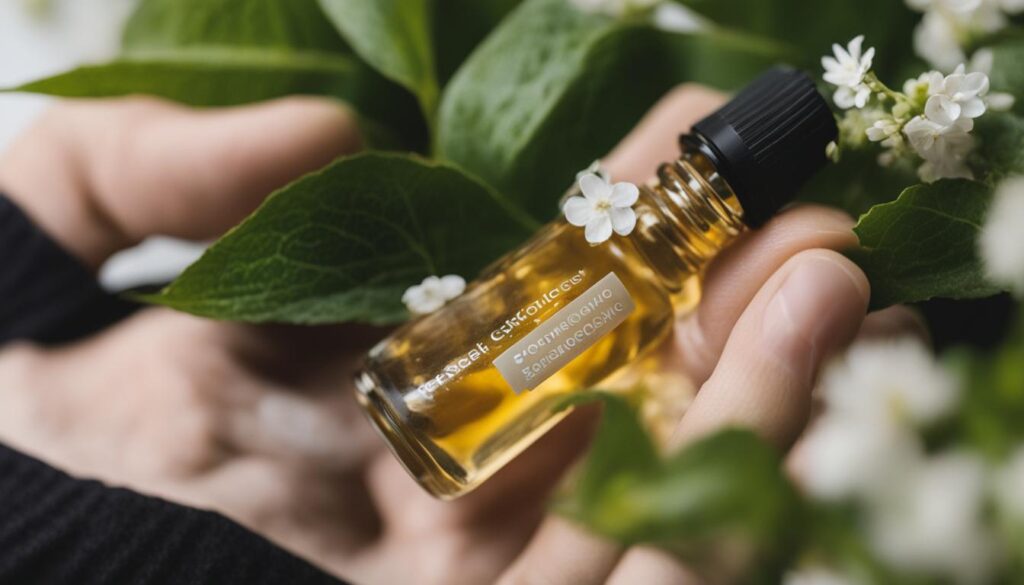Table of Contents
If you’re dealing with seborrheic keratosis, a skin condition characterized by noncancerous growths on the skin’s surface, finding relief can be a top priority. Many individuals turn to natural remedies, and one popular option is essential oils. In this article, we will explore the benefits of essential oils for seborrheic keratosis and identify some of the best oils to consider for soothing and improving the health of your skin.
Seborrheic keratosis growths are typically brown or black in color and can have a waxy or scaly texture. While they are benign and harmless, they can cause irritation, itching, and cosmetic concerns. Natural remedies like essential oils offer potential relief and can help you manage the symptoms of seborrheic keratosis effectively.
Key Takeaways:
- Seborrheic keratosis is a common skin condition characterized by noncancerous growths on the skin’s surface.
- Essential oils have gained attention for their potential benefits in soothing and improving seborrheic keratosis symptoms.
- Tea tree oil, lavender oil, frankincense oil, and geranium oil are among the best essential oils for seborrheic keratosis.
- It is important to dilute essential oils with a carrier oil before applying them to the affected areas.
- Consultation with a healthcare professional is recommended before using any natural remedies for seborrheic keratosis.
1 Understanding Seborrheic Keratosis
Seborrheic keratosis is a benign skin condition characterized by the development of noncancerous growths on the skin’s surface. These growths are typically brown or black in color and have a waxy or scaly texture. While they are harmless, they can be bothersome and may cause itching, irritation, or cosmetic concerns.
“Seborrheic keratosis is a common skin condition that many individuals experience. Although it is not cancerous, the appearance and symptoms can be distressing. Understanding the nature of seborrheic keratosis is important in finding effective ways to manage and treat it.”
Seborrheic keratosis is a relatively common condition and is often seen in individuals over the age of 40. These growths can appear anywhere on the body, but they are most commonly found on the face, scalp, chest, back, and shoulders. The exact cause of seborrheic keratosis is not fully understood, but factors such as genetics, sun exposure, and aging may play a role.
While seborrheic keratosis is typically harmless, it is important to differentiate it from other skin conditions, particularly skin cancers. If you notice any changes in the color, shape, or size of the growths, or if they become painful or start bleeding, it is essential to consult a healthcare provider for further evaluation and diagnosis.
Through a proper understanding of seborrheic keratosis, individuals can empower themselves to make informed decisions about managing their skin health and seeking appropriate treatments when necessary.
2 Benefits of Essential Oils for Seborrheic Keratosis
Essential oils have gained popularity for their numerous potential benefits, including soothing and healing properties. When it comes to seborrheic keratosis, certain essential oils may provide relief from irritation, reduce inflammation, and promote healthier skin. These oils contain bioactive compounds that have been studied for their antimicrobial, anti-inflammatory, and antioxidant properties.
Using essential oils for seborrheic keratosis can offer a natural and gentle approach to managing the condition. These oils can help alleviate discomfort, reduce redness and swelling, and support overall skin health. Additionally, they can contribute to restoring the skin’s balance and improving the appearance of seborrheic keratosis growths.
Some of the most effective essential oils for seborrheic keratosis include:
- Lavender oil: Known for its calming and soothing effects, lavender oil can provide relief from itching and inflammation associated with seborrheic keratosis.
- Tea tree oil: With its powerful antimicrobial properties, tea tree oil can help reduce the risk of infections and prevent further inflammation.
- Frankincense oil: This oil has potent anti-inflammatory properties that can help soothe irritated skin and minimize the appearance of seborrheic keratosis growths.
- Geranium oil: Geranium oil offers regenerative properties that can promote the healing of damaged skin caused by seborrheic keratosis.
These essential oils can be applied directly to the affected areas after diluting them with a carrier oil like coconut oil or almond oil. Simply mix a few drops of the essential oil with the carrier oil and gently massage it into the skin. Repeat this process daily for optimal results.
In addition to their healing properties, essential oils can also have a therapeutic effect on the mind and body. The aromatic scents of these oils can help promote relaxation and reduce stress, creating a holistic approach to managing seborrheic keratosis.
Remember, it’s always best to consult with a healthcare professional or dermatologist before incorporating essential oils into your seborrheic keratosis treatment. They can provide personalized guidance based on your individual needs and ensure the safe and effective use of essential oils.
By harnessing the benefits of essential oils, you can experience relief from seborrheic keratosis symptoms while nourishing and supporting the health of your skin. Incorporating these natural remedies into your skincare routine may help you achieve smoother, calmer, and more comfortable skin.
3 Best Essential Oils for Seborrheic Keratosis
When it comes to managing seborrheic keratosis symptoms, there are several essential oils that have shown promise in providing relief. These oils possess skin-soothing and anti-inflammatory properties, making them effective in soothing irritation and improving the overall health of the affected skin.
Here are some of the best essential oils for seborrheic keratosis:
| Essential Oil | Benefits |
|---|---|
| Tea Tree Oil | Known for its antimicrobial properties, tea tree oil can help reduce inflammation and fight microbial infections on the skin. |
| Lavender Oil | Lavender oil is recognized for its calming scent and skin-soothing properties. It can help reduce redness and promote a healthier skin appearance. |
| Frankincense Oil | This oil has been used for centuries for its skin-regenerating properties. It can potentially aid in reducing the size and appearance of seborrheic keratosis growths. |
| Geranium Oil | Geranium oil is known for its anti-inflammatory and antioxidant properties. It can help reduce redness, swelling, and itching associated with seborrheic keratosis. |
In addition to the individual benefits of these essential oils, creating blends with multiple oils can enhance their effectiveness in managing seborrheic keratosis symptoms. These blends can provide synergistic effects and amplify the soothing and healing properties of the oils.
Experimenting with different essential oil combinations may help identify the most suitable blend for your specific needs. Ensure that you dilute the essential oils with a carrier oil, such as coconut oil or almond oil, before applying them to the affected areas for optimal safety and efficacy.
4 How to Use Essential Oils for Seborrheic Keratosis

When it comes to treating seborrheic keratosis with essential oils, proper usage is paramount. To prevent skin irritation, it is essential to dilute the essential oils with a carrier oil like coconut oil or almond oil. This dilution process ensures that the potency of the essential oils is reduced while still retaining their therapeutic properties.
Once the essential oils are diluted, they can be applied directly to the affected areas of the skin. You can use a cotton ball or gently massage the diluted oils onto the seborrheic keratosis growths. The application should be gentle to avoid further irritation or discomfort.
Before applying essential oils to larger areas, it is recommended to perform a patch test. This involves applying a small amount of the diluted oil to a small area of your skin and waiting for 24 hours. If no adverse reactions or irritations occur during this period, it is generally safe to proceed with using the essential oils for seborrheic keratosis.
Key Points:
- Dilute essential oils with a carrier oil to prevent skin irritation.
- Apply the diluted oils directly to the affected areas using a cotton ball or gentle massage.
- Perform a patch test to ensure the essential oils do not cause any adverse reactions.
| Essential Oils | Carrier Oils |
|---|---|
| Tea Tree Oil | Coconut Oil |
| Lavender Oil | Almond Oil |
| Frankincense Oil | Olive Oil |
5 Other Natural Remedies for Seborrheic Keratosis
In addition to essential oils, there are other natural remedies that may provide relief for seborrheic keratosis. These herbal remedies have been widely used for their anti-inflammatory and antioxidant properties, offering potential benefits for managing the condition. Incorporating these natural remedies into your skincare regimen can help promote skin health and reduce the appearance of seborrheic keratosis.
Aloe Vera Gel
Aloe vera gel has long been known for its soothing and healing properties. When applied topically, it can help reduce inflammation, calm irritated skin, and promote healing. Its moisturizing effects can also alleviate dryness associated with seborrheic keratosis. Simply apply a thin layer of pure aloe vera gel to the affected areas and gently massage until absorbed.
Apple Cider Vinegar
Apple cider vinegar is a popular home remedy known for its antimicrobial and exfoliating properties. It can help remove dead skin cells, reduce itching, and minimize the appearance of seborrheic keratosis. Dilute the apple cider vinegar with equal parts of water and apply it to the affected areas using a cotton ball. Leave it on for a few minutes before rinsing off with water.
Green Tea Extract
Green tea extract contains antioxidants that help protect and rejuvenate the skin. Its anti-inflammatory properties may reduce redness and inflammation associated with seborrheic keratosis. You can apply cooled green tea bags directly to the affected areas or use green tea extract-infused skincare products.
It’s important to note that while these natural remedies have shown potential in managing seborrheic keratosis, individual results may vary. It’s always recommended to consult with a healthcare professional before incorporating any new treatments into your skincare routine.
| Herbal Remedy | Main Benefits | Usage |
|---|---|---|
| Aloe Vera Gel | Soothing, healing, moisturizing | Apply a thin layer to affected areas and gently massage |
| Apple Cider Vinegar | Antimicrobial, exfoliating | Dilute with water, apply with a cotton ball, rinse off after a few minutes |
| Green Tea Extract | Antioxidant, anti-inflammatory | Apply cooled green tea bags or use green tea extract-infused products |
6 Precautions and Considerations
While natural remedies, including essential oils, can be beneficial for seborrheic keratosis, it is essential to exercise caution. Consultation with a healthcare professional is recommended before using any natural remedy, especially if you have underlying medical conditions or are taking medications. Additionally, it is crucial to monitor the skin’s response to the chosen treatment and discontinue use if any adverse reactions occur.
7 Essential Oils for Overall Skin Health
Essential oils are not only beneficial for relieving seborrheic keratosis symptoms but also for promoting overall skin health. These oils possess moisturizing, nourishing, and rejuvenating properties that can greatly improve the texture, tone, and elasticity of your skin.
When incorporated into your daily skincare routine, essential oils can have a transformative effect, leaving your skin healthier and more radiant than ever before.
Here are some essential oils that are known for their skin-enhancing qualities:
| Essential Oil | Main Benefits |
|---|---|
| Lavender Oil | Calming and soothing properties, promotes skin cell regeneration. |
| Tea Tree Oil | Antimicrobial and anti-inflammatory properties, helps combat acne and skin infections. |
| Frankincense Oil | Known for its rejuvenating effects, promotes youthful-looking skin. |
| Geranium Oil | Helps balance oil production, tightens and firms the skin. |
These essential oils can be used individually or in combination to create personalized skincare blends that address specific concerns and promote optimum skin health. However, it is always important to perform a patch test before using any new product to ensure that it is suitable for your skin.
Remember, essential oils are potent, so be sure to dilute them with a carrier oil such as coconut oil or almond oil before applying them to your skin. This will help prevent any adverse reactions or irritation.
By incorporating essential oils into your daily skincare routine, you can unlock the full potential of these natural elixirs and achieve healthier, more vibrant skin.
8 Lifestyle Tips for Better Skin Care
Alongside using essential oils and natural remedies, adopting a healthy skincare routine can support the management of seborrheic keratosis. Here are some lifestyle tips to promote overall skin health and enhance the effectiveness of your seborrheic keratosis treatment:
- Cleanse Gently: Use a mild and non-abrasive cleanser to gently cleanse your skin. Avoid harsh scrubbing that can irritate and damage the skin.
- Moisturize Adequately: Choose a moisturizer suitable for your skin type. Look for moisturizers that are lightweight, non-comedogenic, and hydrating to keep your skin moisturized and prevent dryness.
- Protect from Sun Damage: Apply a broad-spectrum sunscreen with SPF 30 or higher to protect your skin from harmful UV rays. Reapply every 2 hours, especially when exposed to direct sunlight.
- Avoid Harsh Chemicals and Irritants: Read the labels of skincare products and avoid those containing harsh chemicals, fragrances, or potential irritants. Opt for gentle and hypoallergenic options.
- Follow a Balanced Diet: Nourish your skin from within by consuming a diet rich in fruits, vegetables, whole grains, and lean proteins. These nutrient-dense foods can help maintain healthy skin.
- Engage in Regular Exercise: Physical activity promotes healthy blood circulation, which can improve the overall health of your skin. Aim for at least 30 minutes of moderate exercise most days of the week.
- Stay Hydrated: Drink an adequate amount of water to keep your skin hydrated and supple. Aim for at least 8 glasses of water a day.
“Taking care of your skin involves more than just applying treatments. It’s about maintaining a healthy lifestyle and adopting good skincare habits that promote the long-term health and appearance of your skin.”
By incorporating these lifestyle tips into your daily routine, you can optimize the effects of your seborrheic keratosis treatment and improve the overall health of your skin.
| Tips for Better Skin Care | Benefits |
|---|---|
| Cleanse Gently | Prevents skin irritation and damage |
| Moisturize Adequately | Prevents dryness and maintains skin hydration |
| Protect from Sun Damage | Prevents sunburn, premature aging, and skin cancer |
| Avoid Harsh Chemicals and Irritants | Reduces the risk of skin reactions and sensitivities |
| Follow a Balanced Diet | Nourishes the skin with essential nutrients |
| Engage in Regular Exercise | Promotes healthy blood circulation for improved skin health |
| Stay Hydrated | Keeps the skin hydrated and supple |
9 Professional Dermatological Options for Seborrheic Keratosis

In some cases, seborrheic keratosis may require professional dermatological treatment. Qualified dermatologists offer several options that can effectively remove the growths for cosmetic or symptomatic reasons. These treatment approaches include cryotherapy, curettage, electrosurgery, or laser therapy, and the most suitable option may vary depending on individual cases of seborrheic keratosis.
Cryotherapy involves freezing the affected area with liquid nitrogen, which causes the growth to blister and eventually fall off. Curettage is a procedure where the growth is scraped off the skin’s surface using a specialized tool called a curette. Electrosurgery uses high-frequency electrical currents to burn and remove the growths. Laser therapy utilizes focused laser beams to target and vaporize the seborrheic keratosis.
Comparative Table: Dermatological Treatment Options for Seborrheic Keratosis
| Treatment Option | Description | Pain Level | Recovery Time | Cost |
|---|---|---|---|---|
| Cryotherapy | Freezing the growth with liquid nitrogen | Minimal | 1-2 weeks for blister to heal | $$ |
| Curettage | Scraping off the growth using a curette | Minimal | 1-2 weeks for the skin to heal | $ |
| Electrosurgery | Burning and removal of growths using electrical currents | Moderate | 1-3 weeks for scabs to heal | $$$ |
| Laser Therapy | Targeted vaporization of growths using laser beams | Minimal to moderate | 1-2 weeks for skin to heal | $$$$ |
It is important to note that these dermatological procedures should only be performed by qualified professionals to ensure safe and effective results. Consultation with a dermatologist is essential to discuss the best treatment option for your specific case of seborrheic keratosis.
10 Lifestyle Changes for Seborrheic Keratosis Management
In addition to natural remedies and professional treatment options, making certain lifestyle changes can play a significant role in managing seborrheic keratosis. By adopting a holistic approach to skincare and overall well-being, you can promote the long-term health and appearance of your skin.
1. Maintain a Healthy Diet
Consuming a healthy diet rich in antioxidants can support skin health and reduce the risk of seborrheic keratosis flare-ups. Include plenty of fruits, vegetables, whole grains, and lean proteins in your meals to provide your body with essential nutrients it needs to maintain optimal skin function.
2. Avoid Excessive Sun Exposure
Protecting your skin from excessive sun exposure is crucial in managing seborrheic keratosis. Always wear sunscreen with a high SPF, seek shade when the sun is strongest, and wear protective clothing, such as hats and long sleeves, to minimize direct sun exposure. This can help prevent further growth and reduce the risk of skin damage.
3. Practice Good Skincare Habits
Establishing a regular skincare routine can contribute to the management of seborrheic keratosis. Cleanse your skin gently using mild, non-irritating cleansers, and moisturize daily to keep your skin hydrated and nourished. Avoid using harsh chemicals or abrasive scrubs that can potentially aggravate the condition.
“By adopting a holistic approach to skincare and overall well-being, individuals can promote the long-term health and appearance of their skin.”
Remember, lifestyle changes alone may not be sufficient to treat seborrheic keratosis completely, especially if the condition is severe or causing significant discomfort. It is always recommended to consult with a healthcare professional or dermatologist to discuss your symptoms and explore appropriate treatment options.
11 Conclusion
Managing seborrheic keratosis can be achieved through a combination of natural remedies, essential oils, and professional treatments. These options offer potential relief from symptoms and promote healthier skin. However, it’s crucial to consult with a healthcare professional or dermatologist before starting any treatment regimen.
By incorporating natural remedies like essential oils into your skincare routine and adopting a healthy lifestyle, you can enhance your skin’s health and appearance while effectively managing seborrheic keratosis. Remember to dilute essential oils with carrier oils to prevent skin irritation and perform a patch test before use.
Additionally, professional dermatological treatments such as cryotherapy or laser therapy may be necessary in some cases. Consultation with a dermatologist is essential to determine the most suitable treatment approach for your specific condition.
By taking a holistic approach to skincare and following the advice of medical experts, you can effectively manage seborrheic keratosis, promoting long-term skin health and maintaining a radiant appearance.
FAQ
What is seborrheic keratosis?
Seborrheic keratosis is a common skin condition characterized by noncancerous growths on the skin’s surface.
What are the symptoms of seborrheic keratosis?
Symptoms of seborrheic keratosis can include brown or black growths with a waxy or scaly texture, itching, irritation, or cosmetic concerns.
How can essential oils benefit seborrheic keratosis?
Essential oils have soothing and healing properties that may help with irritation, inflammation, and overall skin health in seborrheic keratosis.
What are the best essential oils for seborrheic keratosis?
Tea tree oil, lavender oil, frankincense oil, and geranium oil are among the top choices for soothing seborrheic keratosis symptoms.
How should essential oils be used for seborrheic keratosis?
Essential oils should be diluted with a carrier oil and applied directly to the affected areas using a cotton ball or gentle massage.
Are there other natural remedies for seborrheic keratosis?
Yes, apple cider vinegar, aloe vera gel, and green tea extract are commonly used for their anti-inflammatory and antioxidant properties.
Are there any precautions or considerations when using natural remedies?
It is important to consult with a healthcare professional before using any natural remedy, especially if you have underlying medical conditions or are taking medications.
Can essential oils improve overall skin health?
Yes, many essential oils have moisturizing, nourishing, and rejuvenating properties that can benefit the skin’s texture, tone, and elasticity.
What are some tips for better skin care alongside seborrheic keratosis treatment?
Maintain a healthy skincare routine, including gentle cleansing, suitable moisturizers, sun protection, and avoiding harsh chemicals or irritants.
Are there professional treatment options for seborrheic keratosis?
Yes, procedures like cryotherapy, curettage, electrosurgery, or laser therapy can effectively remove seborrheic keratosis growths under the guidance of a dermatologist.
How can lifestyle changes help manage seborrheic keratosis?
Maintaining a healthy diet rich in antioxidants, avoiding excessive sun exposure, and practicing good skincare habits can contribute to managing seborrheic keratosis.
We may earn a commission for purchases made using our links. Please see our disclosure to learn more. We appreciate your support SO very much.











